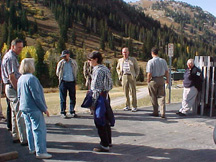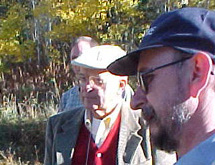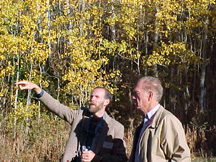Bulletin Board
Experts Study Wasatch Watersheds
Seeking to protect drinking water quality for future generations
October 17, 2000
|
|
The Wasatch Canyons watershed is unique. Situated east of the Great Basin Desert, the mountain range receives up to 60-inches of precipitation at the higher elevations during the winter months in the form of snow. The narrow, steep canyons generate fast moving cold water streams that flow into the populated Salt Lake valley, where the precious liquid is diverted for irrigation and municipal water uses. Moreover, the canyon watersheds are popular outdoor recreation areas. Also within the canyons are residential and commercial developments. Historically, Salt Lake City has strived to protect the canyon’s water resources.
The last comprehensive watershed evaluation was made in 1949, when a board of water engineers conducted a sanitary survey of Salt Lake City’s canyon watersheds, including the Deer Creek Reservoir drainage. The results of that study guided the City’s
|
|
The panel includes nationally recognized water quality experts and academicians from Utah and Colorado universities. Their task -- how to stop a water quality problem before serious degradation takes place. To start the process, the panel will conduct a comprehensive evaluation of each of the canyon watersheds, then develop a monitoring and response plan to accurately measure the various watershed use impacts on the environs and water quality.
The Salt Lake City Department of Public Utilities (DPU) contracted with the engineering firm of Brown and Caldwell (B&C) to develop the “Monitoring and Response Plan.” The task will serve two main purposes: (1) paint a representative picture of the water quality in the canyon streams by collecting the appropriate data, and (2) develop the best methods to protect water quality based on that picture. According to B&C project leader Tom Jacobs, PE “Part of the first purpose, painting an accurate picture, is to provide the necessary scientific basis and guidance for monitoring activities, such as determining how, when and where to monitor water quality to get the most representative data. The ‘scientific basis’ of the plan will build on the current monitoring activities and will address the impact of increasing demands, current and future, on the watershed canyons.”
|
|
Lead person for the DPU is Florence Reynolds, Water Treatment and Quality Administrator. Also representing DPU are Russ Hone, Watershed Administrator and Linda Moss, Process Control Analyst. Representatives from other stakeholders, include the State of Utah Division of Drinking Water, Salt Lake Valley Health Department and the U.S.Forest Service.
At the conclusion of the 3-day workshop, B&C assembled pages of notes for inclusion in the work plan.
One of the first recommendations made by the panel is to change the long-standing routine monitoring program (set day and time of day sampling) to one that measures
|
|
DPU Director, LeRoy W. Hooton, Jr. told the panel that their work was of vital importance to Salt Lake City’s future. “As we have benefitted from the efforts of those who have preceded us, it is our responsibility to ensure future generations clean and safe drinking water,” said Hooton. Citing future growth projections along the Wasatch Front, and the impacts of that growth on the canyon watersheds, Hooton told the panel that (their) “work will help the City meet its greatest challenge -- protecting the watersheds from pollution and maintaining the purity of its drinking water supply.”
The panel will be reassembled at a later date to further the study.
Related news articles:
SLC Adopts Watershed Plan. www.slcclassic.com/utilities/news092699.htm.
Partnerships for Watershed Management: www.slcclassic.com/utilities/news050499.htm
Impacts of the 2002 Olympics: www.slcclassic.com/utilities/news120298.htm
Watershed Law Enforcement: www.slcclassic.com/utilities/news/110698.htm



